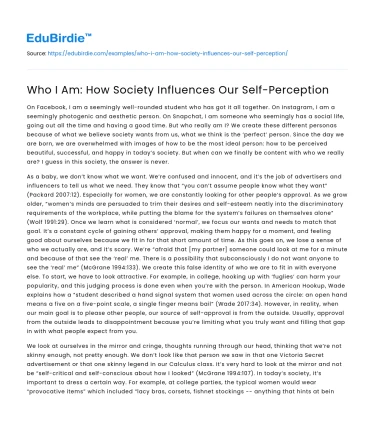On Facebook, I am a seemingly well-rounded student who has got it all together. On Instagram, I am a seemingly photogenic and aesthetic person. On Snapchat, I am someone who seemingly has a social life, going out all the time and having a good time. But who really am I? We create these different personas because of what we believe society wants from us, what we think is the ‘perfect’ person. Since the day we are born, we are overwhelmed with images of how to be the most ideal person: how to be perceived beautiful, successful, and happy in today’s society. But when can we finally be content with who we really are? I guess in this society, the answer is never.
As a baby, we don’t know what we want. We’re confused and innocent, and it’s the job of advertisers and influencers to tell us what we need. They know that “you can’t assume people know what they want” (Packard 2007:12). Especially for women, we are constantly looking for other people’s approval. As we grow older, “women’s minds are persuaded to trim their desires and self-esteem neatly into the discriminatory requirements of the workplace, while putting the blame for the system’s failures on themselves alone” (Wolf 1991:29). Once we learn what is considered ‘normal’, we focus our wants and needs to match that goal. It’s a constant cycle of gaining others’ approval, making them happy for a moment, and feeling good about ourselves because we fit in for that short amount of time. As this goes on, we lose a sense of who we actually are, and it’s scary. We’re “afraid that [my partner] someone could look at me for a minute and because of that see the ‘real’ me. There is a possibility that subconsciously I do not want anyone to see the ‘real’ me” (McGrane 1994:133). We create this false identity of who we are to fit in with everyone else. To start, we have to look attractive. For example, in college, hooking up with ‘fuglies’ can harm your popularity, and this judging process is done even when you’re with the person. In American Hookup, Wade explains how a “student described a hand signal system that women used across the circle: an open hand means a five on a five-point scale, a single finger means bail” (Wade 2017:34). However, in reality, when our main goal is to please other people, our source of self-approval is from the outside. Usually, approval from the outside leads to disappointment because you’re limiting what you truly want and filling that gap in with what people expect from you.
Save your time!
We can take care of your essay
- Proper editing and formatting
- Free revision, title page, and bibliography
- Flexible prices and money-back guarantee
We look at ourselves in the mirror and cringe, thoughts running through our head, thinking that we’re not skinny enough, not pretty enough. We don’t look like that person we saw in that one Victoria Secret advertisement or that one skinny legend in our Calculus class. It’s very hard to look at the mirror and not be “self-critical and self-conscious about how I looked” (McGrane 1994:107). In today’s society, it’s important to dress a certain way. For example, at college parties, the typical women would wear “provocative items” which included “lacy bras, corsets, fishnet stockings -- anything that hints at being sexy underwear” (Wade 2017:27). Wearing, for example, a t-shirt and shorts might even be looked down upon because everyone else has less clothes on than you. The video, ‘Consuming Kids’, gave an example of how we are being influenced by the media and society every day. The more recent Bratz dolls depict a sexier look, wearing less clothes and more makeup. However, Bratz dolls’ target audience are younger girls, ranging from the ages 6 to 12. At a young age, we see these Bratz dolls, the advertisements, the ‘perfect’ people. Over 125 million Bratz dolls were sold in a little less than 5 years. This means that around over 125 million girls were influenced by the Bratz doll looks. The perfect images make us doubt who we are, making us feel insecure and inadequate and thinking that we have to change ourselves to look like these Bratz dolls.
But why do we feel like we are not enough? Because of advertisements, influencers, and today’s marketing tactics. We are trained from a young age that we have flaws, that we are imperfect. We are constantly being “urged by psychological counselors to become ‘merchants of discontent’” (Packard 2007:19). Marketing has a way of always making us want more, making us feel that we are not enough. Because of the way that advertisers like to portray a certain image, it creates a “secret underlife poisoning our freedom, infused with notions of beauty, dark vein of self-hatred, physical obsessions, terror of aging, and dread of lost control” (Wolf 1991:10). We are afraid of being considered ‘ugly’, and, therefore, women fall under the influence of modern marketing and buy cosmetics and other similar products for millions of dollars.
In conclusion, we are being manipulated and controlled by our society today that has been created upon our insecurities. We look at what is being advertised, notice it within our peers and our surrounding environment, and think that we have to look like that as well. But in reality, everyone is unique, and everyone is enough as who they simply are.






 Stuck on your essay?
Stuck on your essay?

